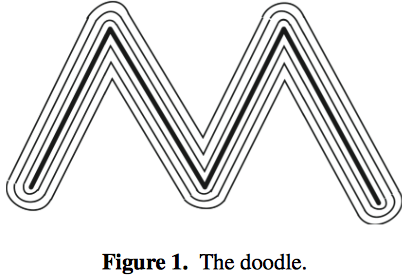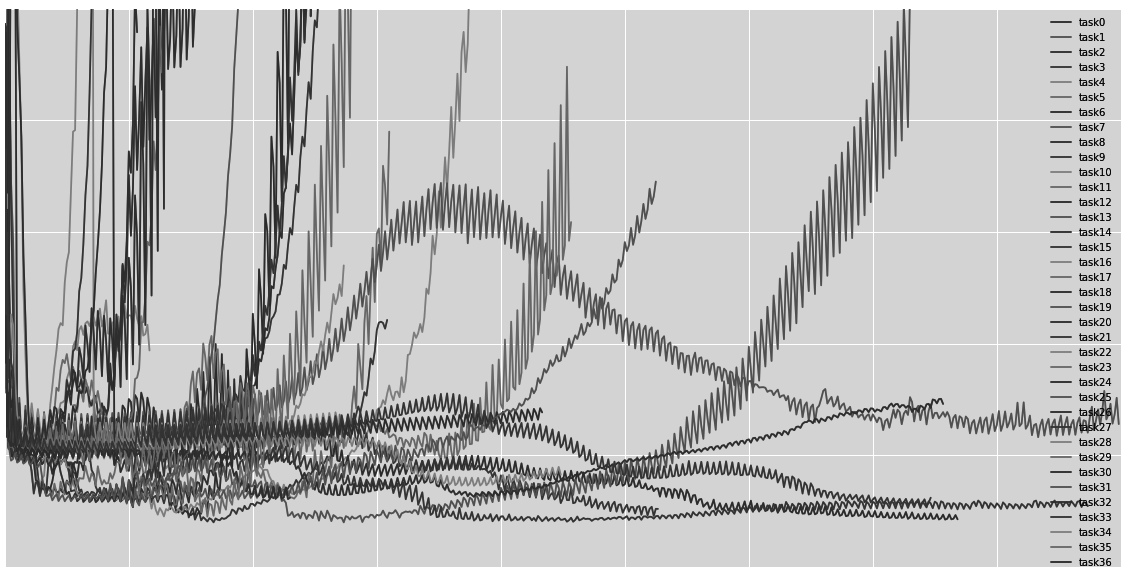First-order methods for regularization
General first-order methods use only the values of objective/constraints and their subgradients to optimize non-smooth (including constrained) function [5]. Such methods that are oblivious to the structure of the problem are termed black-box optimization techniques.
Why first-order?
Primarily because the computation cost, per iteration, of high-accuracy methods like interior-point generally increases non-linearly, which is prohibitively expensive for very large data-sets (> 100K variables).
Though the cost per iteration of general methods is low, these methods cannot exploit the structure of the problem. This post discusses two first-order optimization techniques for regularization problems that can exploit the structure of the problem to give better convergence rate than general methods.
Regularization
Regularization problems in statistics and machine learning, or denoting problems in signal processing, take one of the following forms:
where $|.|$ indicates some kind of a norm (or seminorm), e.g. $L_1$ or $L_2$ in statistics and Total Variation norm in imaging, and $\lambda$ is a real-valued regularization parameter. Optimization of such composite convex functions - often with a smooth component, $f(x)$, and a non-smooth component, $g(x)$ - can be expressed as:
Regularization imposes a structure, using a specific norm, on the solution. For example, using L1 norm encourages sparsity, which often results in more noise-tolerant solutions. This was the motivation behind ridge regression and LASSO [8] in statistical estimation. Unconstrained regularization problems can be solved using (constrained) linear programming while constrained problems may be solved using second-order cone program. Both programs are variants of interior-points algorithms, and too slow for very large data sets. Various first-order methods may be used to solve regularization problem. In fact, for the specific case of regularization problems, first-order method can be shown to converge to an ε-solution at an optimal rate.
Complexity
The complexity of first-order methods is often measured in terms of the number of calls to a first-order oracle (section 5.1 in [5]) required to reach an $\epsilon$-solution. Conversely, the convergence rate gives the approximation error after t iterations. Nemirovski and Yudin’s work [5] established a lower bound for the information-based complexity of black-box optimization techniques: $O(\frac{1}{\epsilon^2})$ iterations (alternatively, an $O(\frac{1}{\sqrt{t}})$-precise solution after $t$ iterations). Furthermore, in many cases, the complexity is still dependent on the dimension, $n$, of the problem - $O(n)$, in the worst case. For very large dimensional problems, such black-box schemes would converge too slowly.
Nonetheless, there are large classes of problems - including regularization - for which the complexity is $O(\frac{1}{\epsilon})$ or, in some cases, $O(\frac{1}{\sqrt{\epsilon}})$ (theorem 3.8 in [7], section 5.1 in [9] [10, 12]). In such cases, the complexity is also either independent of or only sublinearly dependent on problem dimension, making them feasible for very large dimensional but medium-accuracy problems (such as those in machine learning).
Why not use polynomial-time interior-point methods for convex optimization?
While interior-point methods converge rapidly - $Ο(e^{Ο(t)})$ - to an ε-solution, the complexity of each iteration is super-linear - $O(nk)$, $k > 1$. For very large dimensional problems, these methods are prohibitively expensive.
Proximal algorithms
For the composite function optimization problem, we assume that:
- the problem has a unique minimizer
- $f(x)$ is $\beta$-smooth, convex and differentiable
- $g(x)$ is convex, subdifferentiable and “simple” (to be clarified later)
From the definition of $\beta$-smooth convex function, f(x):
For subgradient descent from a given a point $x_k$, we need to find the next point xk+1 such that $f(x_{k}+1)$ is minimized i.e [3].
For the composite function, $f(x) + \lambda g(x)$, this becomes
which can be reduced to
Despite the fact the each iteration here involves another optimization, a wide class of problems in this form can be solved with proximal minimization algorithms [13, 14]. Proximal algorithms minimizing a $\beta$-smooth function $f(x)$ can in general be represented as:
where $\eta = \frac{1}{\beta}$ and the proximity operator, $prox_{\eta}f(y)$, of a scaled function $f(x)$ is defined as
For the composite function, $f(x) + \lambda g(x)$, this implies
Proximal algorithms are useful when the optimization subproblems either admit a closed-form solution or can be rapidly solved numerically. If this is the case, then $g(x)$ is considered “simple.” For example, $g(x)$ in regularization problems is an $L_p$ norm, where p = {1, 2, $\infty$}. Using the calculus of proximity operators, it is possible to evaluate the closed-form solutions for these norm:
$prox_{\eta,|.|_{1}}(y)= \begin{cases} y-\eta, & y \ge \eta \ 0, & |y| < \eta \ y+\eta, & y \le \eta \end{cases}$
This operation, for $L_1$ norm, is also called soft thresholding.
$prox_{\eta,|.|_{2}}(y)= \begin{cases} (1-\frac{\eta}{|y|_2})y, & |y|_2 \ge \eta \ 0, & |y|_2 < \eta\end{cases}$
The operation for $L_2$ norm is also called blockwise soft thresholding.
How rapidly would this scheme converge for composite functions compared to subgradient descent (since $g(x)$ is non-smooth)? Since the proximal algorithm does not need to evaluate the subgradient of $g(x)$ - only the gradient of $f(x)$, which is $\beta$-smooth - the convergence rate should the same as that $f(x)$. Following Theorem 3.3 in [7], given the minimum $x^{\ast}$,
which is much faster than subgradient descent’s $O(\frac{1}{\sqrt{k}})$. Improving convergence rate to $O(\frac{1}{k^2})$ [1,2] will be the topic of our next post.
## Corrupted signal and model
x <- c(1, 2, 3, 4, 5, 6)
t <- seq(from = 0, by = 0.02, to = 2*pi)
A <- cbind(sin(t), sin(2*t), sin(3*t), sin(4*t), sin(5*t), sin(6*t))
e <- -4+8*rnorm(length(t),0,1)
#e[100:115] <- 30
y <- A %*% x + e
plot(t, A %*% x, 'l', col='blue', ylab = "signal", xlab = "time")
lines(t, y)
## Proximal algorithm for l1
## parameters
iter <- 1000
beta <- norm(A, type="F")^2
eta <- 1 / beta
lambda <- 1
xx <- c(0, 0, 0, 0, 0, 0)
## main loop
for (i in 1:iter) {
gradient_x <- t(A) %*% ( A %*% xx - y )
xx_tmp <- xx - eta * gradient_x
v <- eta * lambda
# L1 prox/shrinkage-thresholding
xx <- pmax(xx_tmp - v, 0) - pmax(- xx_tmp - v, 0)
}
xx
lines(t, A %*% xx, col="red")
legend("topright", legend=c("original signal", "corrupted signal", "recovered signal"),
col=c("black", "blue", "red"), lwd=c(1, 1, 1))
 Signal recovery using L1-Prox
Signal recovery using L1-Prox
References
- 1 A. Beck, M. Teboulle. A Fast Iterative Shrinkage-Thresholding Algorithm for Linear Inverse Problems. SIAM J. Imaging Sciences, 2009
- 2 S. Becker, J. Bobin, E. Candes. NESTA: A Fast and Accurate First-Order Method for Sparse Recovery. Technical Report, Caltech, 2009
- 3 http://blogs.princeton.edu/imabandit/2013/04/11/orf523-ista-and-fista/
- 4 M. Teboulle. First-Order Algorithms for Convex Optimization. IPAM, 2010
- 5 A. Ben-Tal, A. Nemirovski. Lectures on Modern Convex Optimization. Lecture Notes, 2013
- 6 http://en.wikipedia.org/wiki/Subgradient#The_subgradient
- 7 S. Bubeck. Theory of Convex Optimization for Machine Learning. Lecture Notes, 2014
- [8] T. Hastie, R. Tibshirani, J. Friedman. Elements of Statistical Learning. Second Edition.
- 9 Y. Nesterov. Subgradient Methods for Huge-Scale Optimization Problems. ECORE Discussion Paper, 2012
- 10 A. Juditsky, A. Nemirovski. First-Order Methods for Non-Smooth Convex Large-Scale Optimization, 1. Optimization for Machine Learning,
- [11] J. F. Bonnan, J. C. Gilbert, C. Lemaréchal, C. A. Sagastizábal. Numerical Optimization: Theoretical and Practical Aspects. Second Edition, Springer, 2006
- 12 A. Beck, M. Teboulle. Smoothing and First Order Methods: A Unified Framework. SIAM Journal Of Optimization, 2012
- 13 N. Parrikh, S. Boyd. Proximal Algorithms. Foundations and Trends in Optimization, 2014
- 14 P. L. Combette, V. R. Wajs. Signal Recovery by Proximal Forward-Backward Splitting. Multiscale Modeling and Simulation, 2005
Credits
The image comes from regularize.wordpress, and shows a 3d Mairal-Yu simplex, the equivalent of a Klee-Minty cube for the $L_1$ homotopy method.

